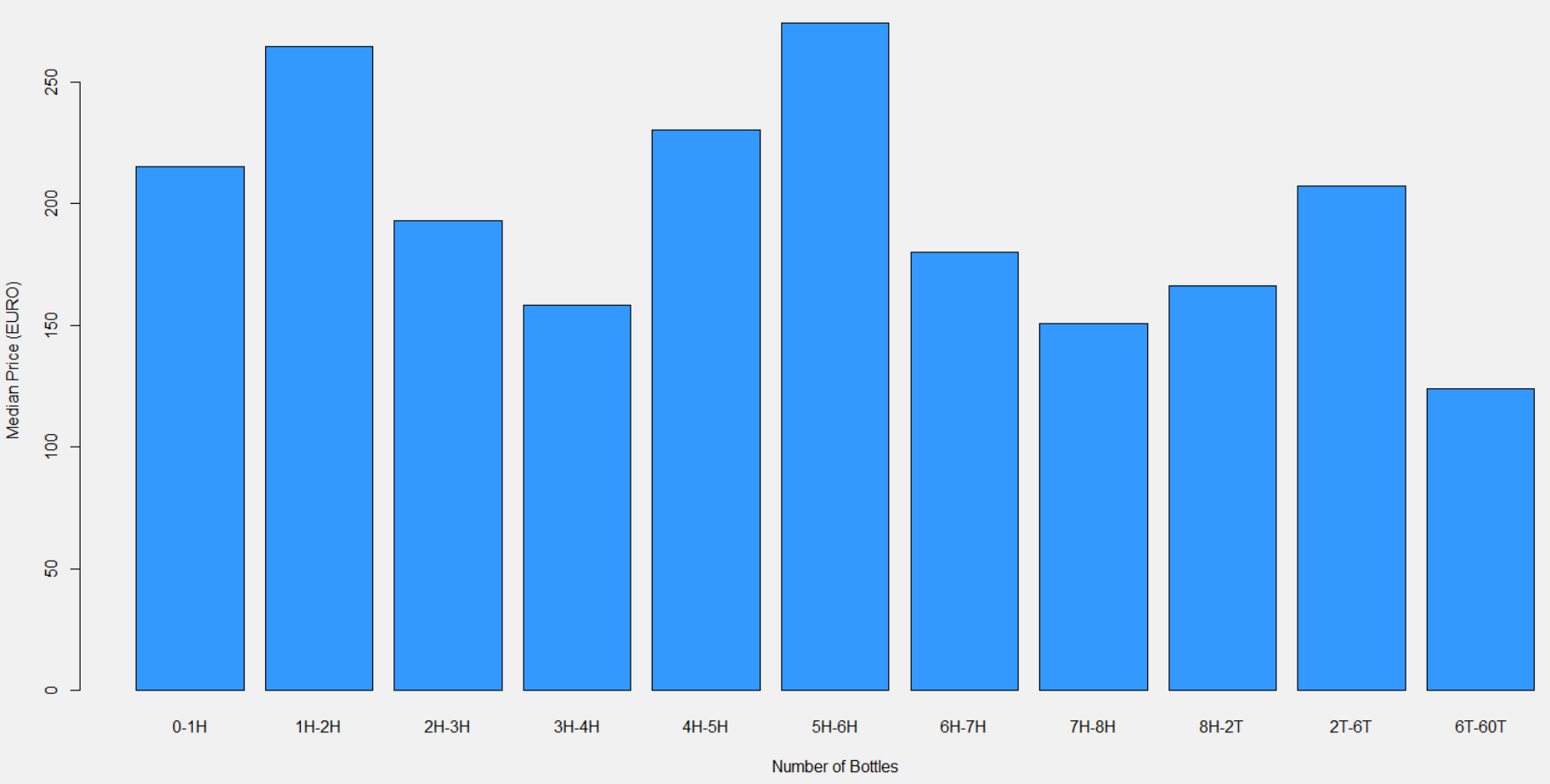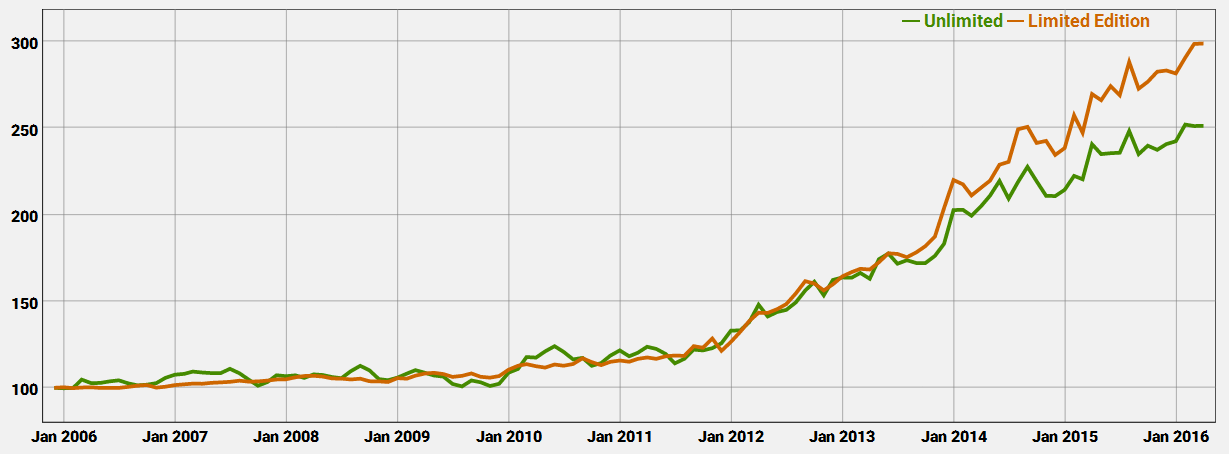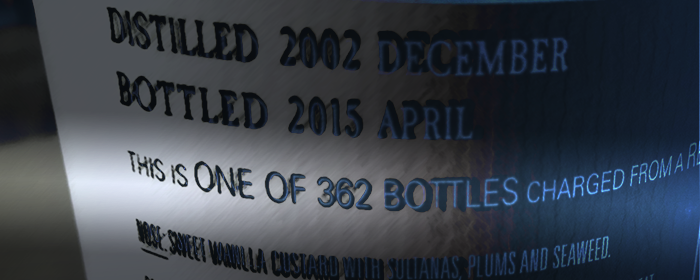We take a closer look at limited editions. What does it really mean? How many bottles of a “limited” edition whisky can there be? Does the number of existing bottles affect the price? Many questions, and we sure found some answers.
Our observations of the latest whisky auctions included the second price for the Highland Park Ice Edition and hence this whisky was added to our database. Beside its pricing, it was the quantity of 30.000 bottles marketed as “limited edition” that caused many controversial discussions. We hereby do not want to judge this marketing strategy. We rather took it as a reason to have a closer look at the number bottles there exist of the whiskies in our database.
What is Limited?
A collector´s best friend is rarity. The less equal exemplars there are, the more special it is to own one. Traditionally, the rarity of whisky is caused by the size of a barrel or the number of barrels in a batch and of course by the amount of time the liquid has to spend in these barrels. So if a whisky is released as a single cask whisky, the number of bottles of that edition is limited by the number of bottles that come out of the barrel. Naturally, these are the whiskies which are the most interesting for collectors since they can not be reproduced. As the customer is willing to pay more for something special, we now see bottling series which “limited” quantities can not be explained by natural limitations like the size of the barrel or the batch anymore. At this point however, we shall not forget that it is of course not possible to produce each whisky forever and therefore it is only natural to stop production at some point or limit the quantity in the first place.
In our whisky database we find a limited amount of bottles for exactly 49,2% of the whiskies. At the time of writing these article, this means that out of the total 17.208 single malt whiskies in our database, 8.522 are limited editions. For 50% of these limited edition whiskies, there exist less than 308 bottles. In fact, there are only 318 limited edition whiskies where there exist more than 3.500 bottles. We here use 3.500 as a threshold on how much bottles there can be in a reasonable batch. Actually, we only find six batches in our database with more bottles (between 10.000 and 15.000 bottles). In any case, it seems like most of the limited editions are real limited editions, i.e. the limitation is naturally caused.
Not So Limited At All
By now we found out that most of the limited edition whiskies are limited due to natural reasons. There are, of course, exceptions which we now want to point out. On top of this list is the Talisker (175th Anniversary) Edition. A whopping 60.000 bottles were released which is probably the reason why this whisky is available at the primary market for more than ten years now. The second place is shared by the Highland Park Ice Edition and the Port Charlotte PC 8 with both 30.000 bottles. The top eleven of the most unlimited limited editions are completed by the following listing:
- (Place 4) Bruichladdich 5yo (2006) Islay Barley: 24.000 Bottles
- (4) >Port Charlotte PC 7: 24.000 Bottles
- (4) Bruichladdich 7yo (2001) The Resurrection Dram: 24.000 Bottles
- (7) Highland Park Thor: 23.000 Bottles
- (8) Talisker 12yo (Decade of Friends of the Classic Malts 2007): 21.500 Bottles
- (9) Highland Park Loki: 21.000 Bottles
- (9) Talisker 25yo 2004 Release: 21.000 Bottles
- (11) Highland Park Freya: 19.000 Bottles
Most interestingly there are only three different distilleries which are represented in this list. These are Talisker, Highland Park and Bruichladdich (Port Charlotte). If we further look down the list, it is especially Bruichladdich with its Port Charlotte and Octomore releases which seems to follow its very own interpretation of the word “limited”.
Truly Limited
We now turn our attention to the other extreme. In our database we find some true rarities, where most of them are of course private cask bottlings and were never really available on the primary market. The rarest of the rare is the Bowmore 21yo (1990) Private Cask 0001. As there exist only five bottles, chances are high that you will miss out of this one. Ten bottles exist of the Caol Ila 27yo (1983) Private Collection and the Isla of Jura 14yo Special Edition, which make them the second rarest single malt whiskies. It seems like the chaps at Bruichladdich are friends of the extreme. We find several Port Charlotte Private Cask Bottlings among the rarest whiskies. There is, for example, the Port Charlotte 7yo (2001) Private Cask Bottling which prices climbed from 150 Euros in August 2010 to 315 Euros in December 2015.
The Effect of Limitation
We would now like to know if the number of produced bottles affects the prices on the secondary market. For this purpose we only consider those bottlings for which we have at least one price observation in the last 12 months. Out of the 8.522 limited editions whiskies 4.695 meet this criteria. We then grouped this 4.695 whiskies into eleven bins based on the number of produced bottles (you can see the bins in the below image where “H” denotes Hundred and “T” Thousand). For each of these eleven bins we computed the median price (see this Wikipedia post on the Median for more information). Based on this analysis, we cannot conclude that there is a direct connection between the exact number of bottles produced and the price of a whisky. We observe the highest median prices for the whiskies with 100-200 bottles and 500-600 bottles produced.
Based on this analysis, we cannot conclude that there is a direct connection between the exact number of bottles produced and the price of a whisky. We observe the highest median prices for the whiskies with 100-200 bottles and 500-600 bottles produced.
So maybe it is not the exact number of bottles produced that is relevant for the price. Maybe it is just the fact that whether the number of bottles is limited or not. To find out, we compare the latest prices of the limited edition whiskies (the 4.695 from above) and whiskies without a bottle limitation for which 5.071 meet the criteria of having at least one price observation in the last twelve months. For these two sets of whiskies we simply compare the corresponding latest auction results. We see that all the prices we used for comparison are smaller for unlimited than they are for limited editions. The median price for limited editions is 45 Euros higher. The average price of limited editions is even 100 Euros above its “unlimited” counterpart. Even the minimum and maximum prices follow this pattern. Hence, it seems like the knowledge about the number of available bottles does significantly affect the secondary market prices. Does the same hold for the historic price evolution?
We see that all the prices we used for comparison are smaller for unlimited than they are for limited editions. The median price for limited editions is 45 Euros higher. The average price of limited editions is even 100 Euros above its “unlimited” counterpart. Even the minimum and maximum prices follow this pattern. Hence, it seems like the knowledge about the number of available bottles does significantly affect the secondary market prices. Does the same hold for the historic price evolution?
Limited vs. Unlimited
We now want to use our database of historic whisky auction prices to compare the price evolution of limited editions with those of bottling series without a stated number of produced bottles. The method of choice to do so here at Whiskystats is to compare the price history of the 100 most traded whiskies. That means we simply computed the indices of the 100 most traded limited editions and the 100 most traded “unlimited” whiskies.
It was in June 2013 where these two indices were the same for the last time. Since then the limited editions won 69% in value. Over the same period, the prices for the 100 most traded unlimited whiskies climbed by 42%. So there is indeed a difference. Another very interesting fact is that both these indices show a similar behavior over the last couple of years. They gained significantly in the end of 2013 and lost ground in the second half of 2014. August 2015 showed a remarkable peak for both indices. Also, now in May 2016 both the 100 most traded limited editions and unlimited whiskies are as valuable as they have never been before.
We learned that limited edition can mean anything from five to 60.000 bottles. Most limited editions are limited due to natural reasons like cask or batch sizes. We saw some extraordinary examples for both, very rare and very unlimited limited editions. We found out that it is not the exact number of bottles but rather the limitation itself which affects the secondary market prices. A look at the historic prices showed that limited editions gained 27% more in value since June 2013 than their unlimited counterparts did.
